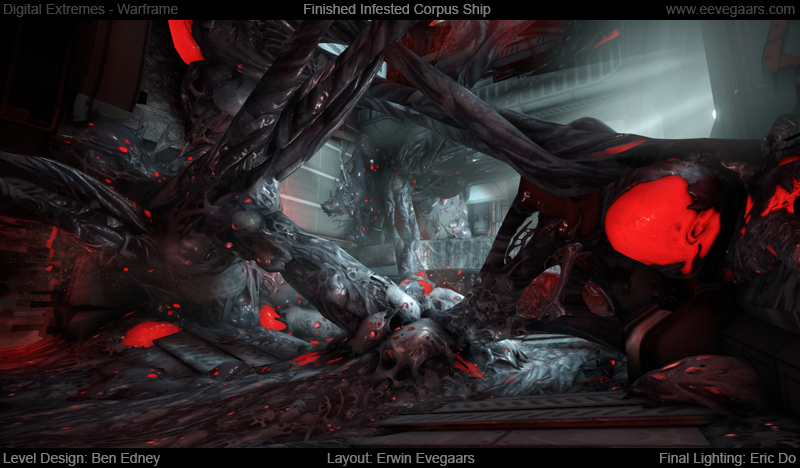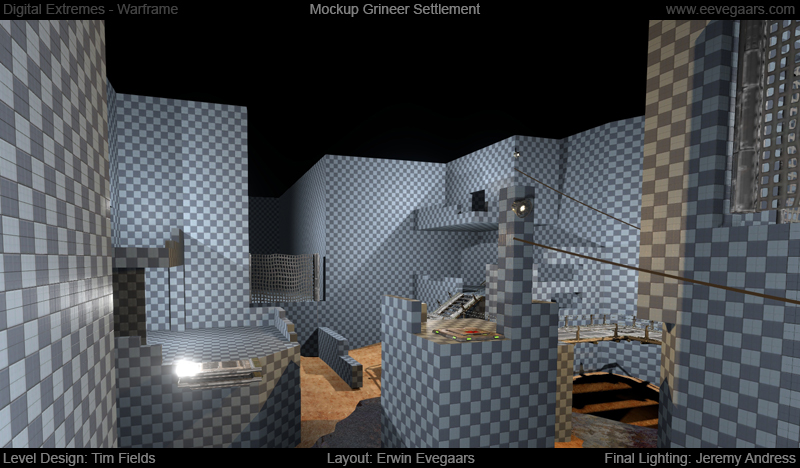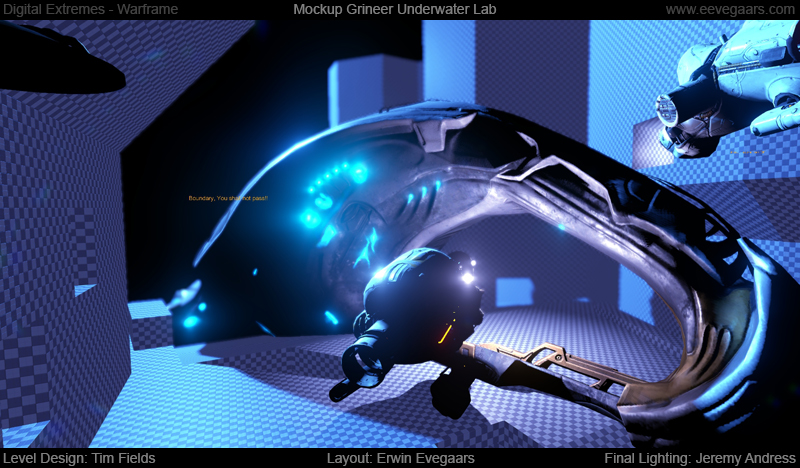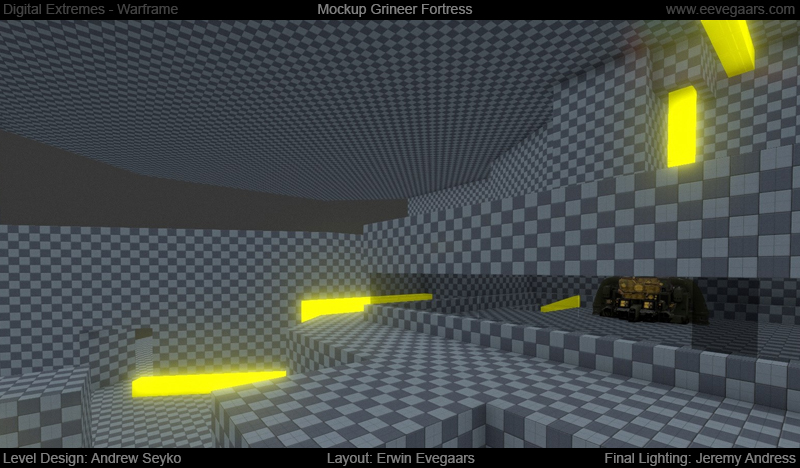In good communication with a Level Designer and the Art Director I was responsible for the artistic layout and composition in the assigned videogame environments. This was done by creating life in an otherwise static mockup by telling stories using a visual medium. All the while ensuring it is in line with any technical constraints and artistic direction.
All shown images except Duviri include both a first and second pass lighting and effects done by my hand. Most of the end-results received a final pass done by a designated lighting- and effects-artist. However my original setup was often respected and merely polished. There are some cases where I ended up doing the final lighting and effects as well, such as the Infested Orokin tileset.
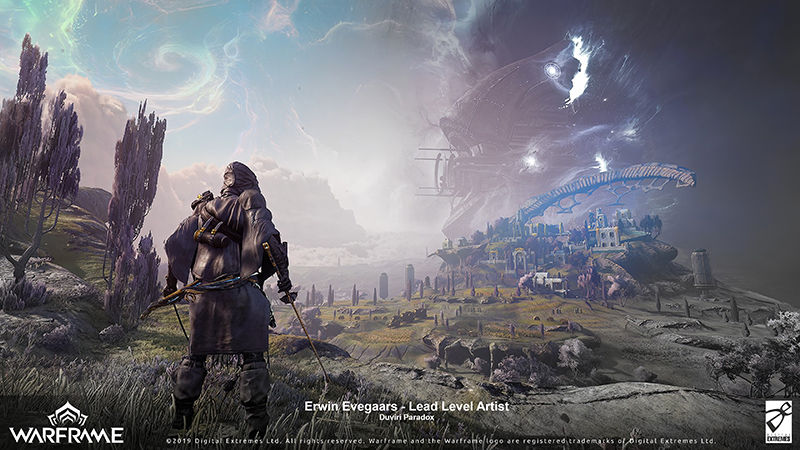

For
Duviri I started out doing research and development on all the natural
related thematics while in constant communication with both the Art Director
as well as the Environment Art team who were making the objects I needed.
On a 100x200m space I tested out both foliage growth and rock formations
on multiple environments, ranging from meadows and gardens to forests
and swamps. Once approved they would first get automatically applied using
a scatter system so we could cover and test large environments for gameplay,
visuals and performance. Later I would go back and adjust most of these
placements for optimal story telling and compositional results that best
matched my initial tests. I ended up doing foliage and rock placements
as well as dirt roads and hiking trails on all 3 main islands as well
as the Amphitheatre island and the Fractal Pasture in the Undercroft.
Last but not least, I set up little story telling elements such as patio-tables,
plant-clusters, stable-tools, blacksmithing locations, and lounging areas
that we could then spread throughout the world.
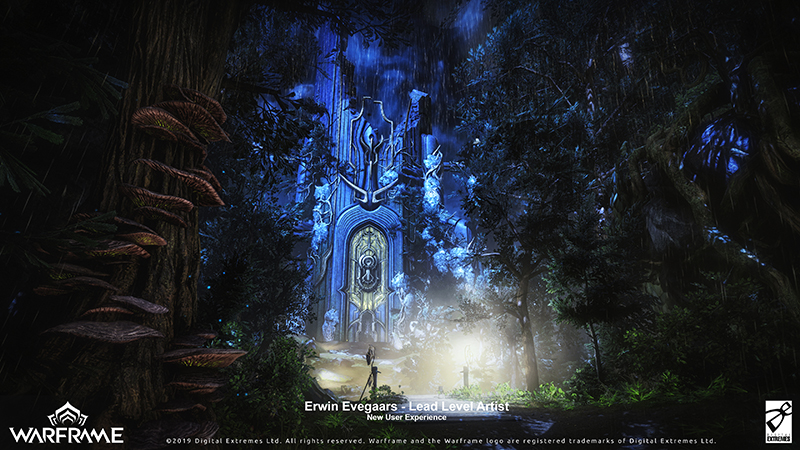
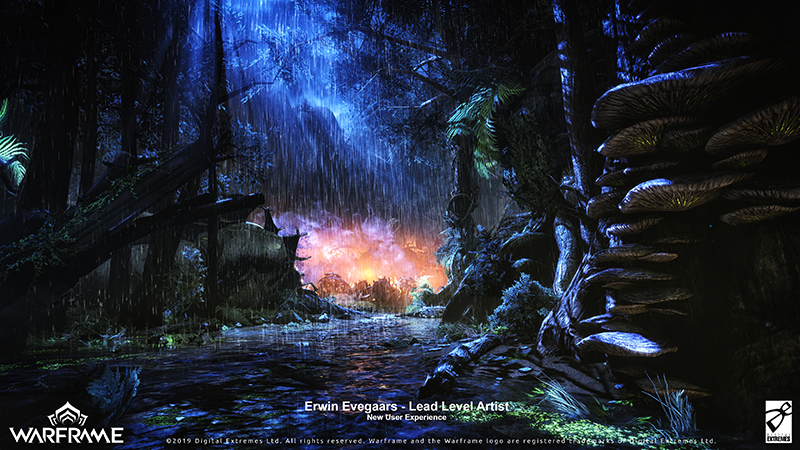
This quest-line was created to replace our former tutorial level. It was acompanied with a pre-rendered cinematic introduction followed up with further ingame cutscenes at which point the tutorial starts that take place in environments put together entirely by me, both Level art and most of the general Level Design, exluding the tutorial specific parts. It was made using a mix of existing props from the game and as well new ones for which I often created proxies to have something to work with while environment art finalized them. Proxies included large seqoia inspired trees and their roots as separate pieces. As well as structural debris for the Orokin ruins and background cards for trees. Several other pieces were reused from the Plains of Eidolon, Cetus, Venus and Grineer Forest. Several smaller environments towards the end were as well reused from the Grineer Forest set and enchanced to match both quality and story telling of the questline. This helped save a lot of time considering it was made with a very small team, which we could then use to focus on the much larger first half of the quest.
Driftercamp was part of the New War update. I was responsible for applying a war-torn pass on the Plains of Eidolon which included craters, fallen trees, ship debris and swapping some existing structures for a broken version. I was as well responsible for all the Level Art in the Driftercamp, with the Level Design done by Andrew Seyko. This was a whole new environment meant to become the home of the Drifter character. Almost everything was reused from other sets such as Plains of Eidolon, Cetus, Venus, Grineer Forest and New User Experience. Having this not be part of a procedural system gave me more freedom and the oppertunity in creating a larger environment that suited the story we were trying to tell. The main challenge was that this level would be available directly from the menu. This required it to have minimal loading time and therefore keeping it very low on memory use.
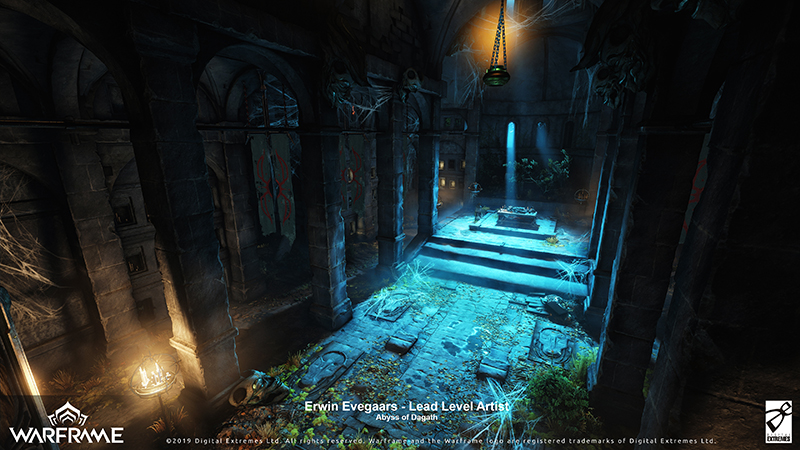
This is a personal favorite of mine as it is entirely my own Level Art creation. It was a brief project with a lot of thematic freedom and was a wonderful change from the large and open Duviri update that I had just come out of. The room was meant to house a Warframe that at the time wasn't made yet outside of concept and there was no script either. The only requirements were to give it a horror/halloween thematic, stick to the Dojo metrics, it needed a place for said Warframe character and as well a stable for horses of any kind..
Being a big fan of medievil architecture and knowing horses would have some sort of role I chose to go with a crusader-inspired chapel. For the basic architecture I took most inspiration from existing chapels churches and tombs from that era. Furthermore I took to movies such as Kingdom of Heaven, Interview with a Vampire, Sleepy Hollow as well as the classic monster movies from the 30's . Most of those may not have had a medieval thematic, but were great for to look at for theatric and dramatic atmosphere. To build the basic structure I reused pieces from the old Grineer Settlement. The additional pieces that added detail and patterns on the floor are Orokin and so are the pieces I used for the chandeliers. The only new additions are the tomb itself, the banners and the stable accessoiries.
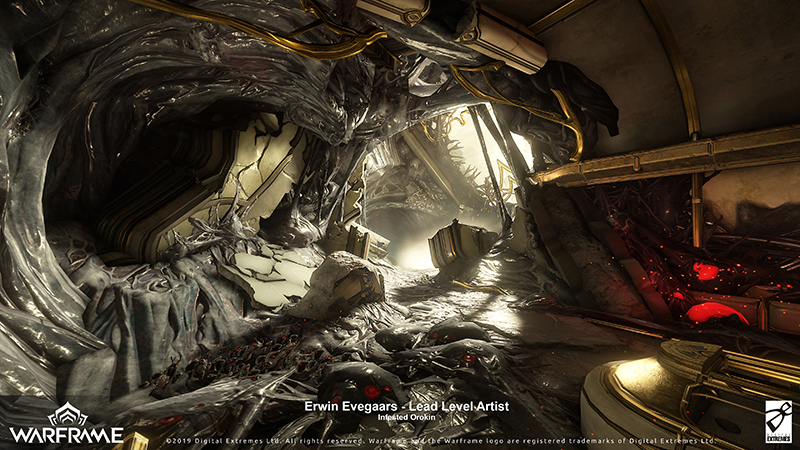
This set was part of the Railjack update we released and let people explore the derelict towers in the area which at times could be linked to quest-lines surrounding the dedicted Railjack experience. As the set is fairly small and contained, the Level Art, lighting and effects placement were all entirely done by me. While I used some existing Orokin rooms as a start-off point, applying an infested pass on them often resulted in an entirely different level. This is because I wanted to make it a unique experience to see the architecture in this state. There are as well some levels, such as shown in the image above, that were created entirely from scratch by me.

I was on the forefront of
Grineer Forest as well as leading the charge on the Remastered version
of this set a couple years later. This included creating proxy pieces
such as trees and rocks and a cave kit as well as beautiful corner prototypes
that matched the art direction and set a visual example and guideline
for the rest of the team. The remastered version included all new materials,
sounds and lighting, but from a Level Art standpoint I also went through
each and every level to look for improvements to be made and apply more
consistency in art direction per room.
There were also some technical advances made in between the original set
and the remastered version such as the foliage system. This allowed me
to not only learn and then apply this to the level, but as well teach
my peers how to use them. This technology would later be improved upon
further and applied to the Plains of Eidolon of which I as well had a
large hand in putting together.
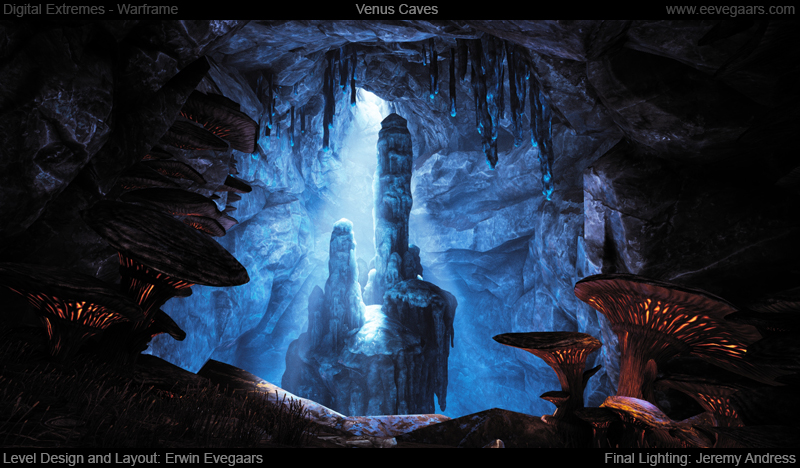
For Orb Vallis, aka Venus,
I worked directly with Kol Crosby as the Level Designer and was co-responsible
for Level Art in all the Caves with Mitch Gladney. Outside of the caves
I also did two large craters that can be found on the surface.
To quickly and efficiently build Level Art for all these caves with just
the two of us, I designed a cave-kit that could comfortably follow all
the Level Design needs without too much kit-bashing. This could then be
dressed up with a more detailed pass to get interesting and unique compositions.
This kit included pieces such as straight, corner, 3-way, fourway, entrance
and cap which could all comfortably be used upright, upside down, facing
each other in a mirrored way and combined with terrain to give us the
most versatile results. This kit would later be reused for New User Experience
among other areas.
Before and after comparisons
The images
below are acompanied by a screenshot of the mockup showing how I often
received the original Level Design.
The level designers focus on the gameplay path and pacing of the level.
I will then visualize this to the desired art direction of the set by
using set pieces created by the Environment Art team.
